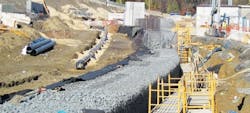The Croton system is the oldest of New York City’s three systems, which include Croton, the Catskill and the Delaware water supply systems, and provides drinking water to the city and upstate communities. The actual watershed of the system lies in reservoirs and lakes in northern Westchester and Putnam counties. The Croton watershed encompasses a total of 375 sq miles.
The water flows by gravity from the upland storage reservoirs through a series of tunnels to the Jerome Park Reservoir, which is located at the downstream end of the Croton system in Westchester County, and then to the New York City tanks. To put the amount of water into perspective, the Croton system supplies approximately 10% of the city’s average demand and provides water to both the Bronx and Manhattan.
An Upgrade
As the largest single construction contract in New York City history, the $2.5 billion Croton Water Filtration Plant project began in 1989 and will be the newest addition to the New York City water system, which first began service in 1842. Once finished, the Croton plant will have the capacity to treat 1.2 million cu meters of water per day.
The project was conceived as the plan of action for New York City to meet the requirements of the New York State Sanitary Code and the U.S. Environmental Protection Agency Surface Water Treatment Rule, a National Primary Drinking Water Regulation included in the Safe Drinking Water Act of 1974.
Maccaferri Inc. became part of the project when its gabions were selected as the method of providing soil reinforcement for the project. Maccaferri gabions are rectangular wire mesh baskets filled with rock at the project site to form flexible, permeable, monolithic structures such as retaining walls for commercial, industrial and road projects. When gabions are filled with stone, they become large, flexible building blocks from which a broad range of structures can be built. Gabions also are used for erosion control, bank stabilization, channel linings and weirs.
The main advantages of gabions are their strength and flexibility. Their wire construction can tolerate differential settlement without fracture. Hydrostatic pressure does not build up behind the gabion units because of their permeable nature. The ability to combine drainage and retention functions makes gabions ideal structures for slope stabilization.
The strength of Maccaferri’s gabions comes from a double twisted hexagonal steel wire mesh that is reinforced by selvedges of heavier wire running along the edges and by transverse diaphragms. The double twisted wire will not unravel, even when the gabion is cut.
For this project, a gabion wall would surround the facility and utilize a geosynthetic fabric to contain the backfilled soil. One requirement by the designer was that it had to be a pleasant-looking façade because it would be visible to the public. The lines of the baskets needed to line up. There could be no bulges, and the stone needed to be placed in an appealing pattern.
Review & Results
This was a standard installation, but one feature was not approved. The double twisted wire mesh, which has been used around the world, was set to have a PVC coating to help it withstand the effects of exposure to the environment. This combination is a standard process that is preferred where there is saltwater or hard conditions.
During the review of the product specifications, members of the New York City Department of Environmental Protection (NYCDEP) and New York State Department of Environmental Conservation (NYDEC) became aware of the PVC coating and raised concerns about potential leaching of chemicals into the drinking water. Raw galvanized metal was not acceptable, either, so a new solution was needed. The technical departments of the U.S., Italian and Brazilian Maccaferri organizations worked together to develop what they thought was the best solution and presented their suggested solution to the construction oversight team in early 2012.
The northeast area manager for Maccaferri, Richie Prejs, stated the company was able to come together to tackle the issue. “To pick up the phone and have access to that depth of experience was fantastic,” he said. “For the most part, we don’t really work that closely with the Italian company, but as soon as we asked, they were fully engaged. The Brazil unit was also helpful.”
The product suggested by the Maccaferri team was called PA 6 (Polyamide 6)—a polymer-based coating that offers improved environmental and technical performance when compared with PVC-coated products on the market. It has greater environmental performance, and is resistant to mechanical damage and cold temperatures, as well as hydrocarbon pollutants. PA 6 also has long-term strength and elasticity and exceptional adhesion to the wire. Shortly after, both the NYCDEP and NYDEC approved the product, and the gabion wall portion of the project began in August 2012.
While this phase of the project was not seriously delayed because of the issues raised by the agencies, there was some time lost while the alternative products were explored. Once approved, the installation training began and the Maccaferri team built a small test wall to show the construction crew the proper way to arrange the baskets, secure them and arrange the inserted rock. Construction began on the actual wall shortly after the training was finished, and the full gabion/fabric project should be completed by the end of 2014, with the entire Croton project scheduled to be completed in 2016.
Craig Foster is marketing manager for Maccaferri Inc. Foster can be reached at [email protected] or 301.223.6910.
Download: Here


